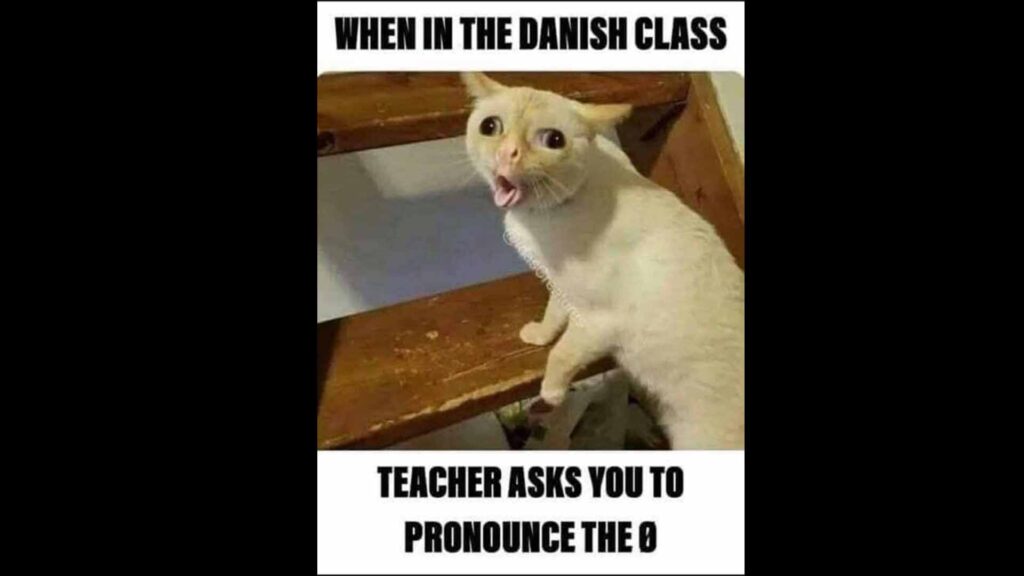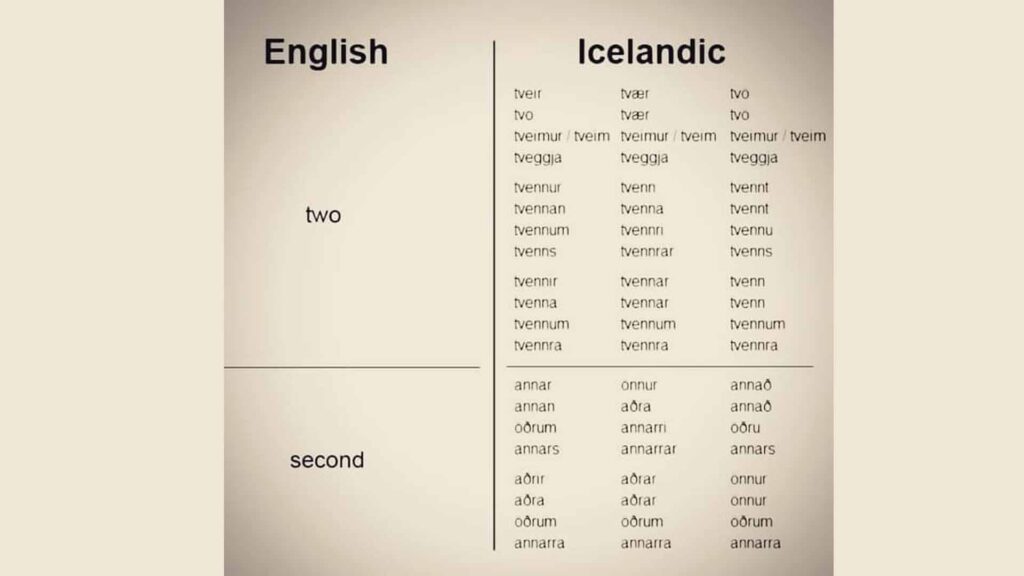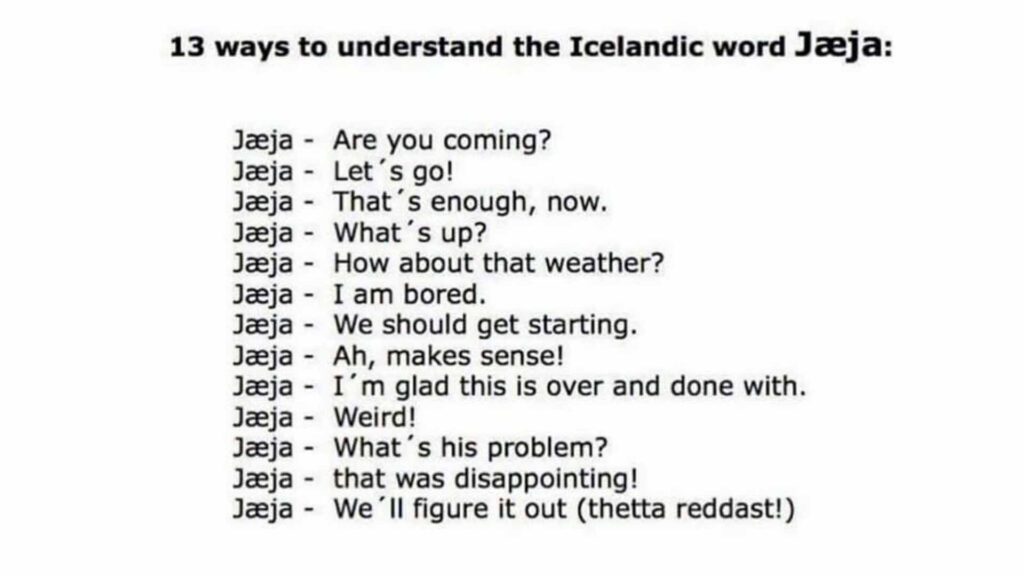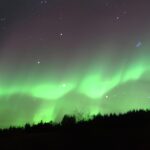Or how much Icelandic should you learn before visiting?
First things first, most Icelanders speak excellent English – at least well enough to help you should you need it. And if they don’t, they know someone who does.
But it doesn’t go amiss to learn a few phrases. It is both fun, and you will be able to show off to your friends!
A Short History of Icelandic

Icelandic is one of the older languages in use today; it has gone through a few changes since its settlement over 1000 years ago. Icelanders speak basically old Norse, but of course, with some changes. We have added words, others have changed their meaning, and yet others are all but forgotten. But the basic syntax remains, and Icelanders generally can read the old sagas, for example.
Icelanders try to find a new word for most foreign words that come into the language. Some words, like “basically”, “random”, and “attitude”, are probably here to stay, as are a myriad of swear words (as most Icelandic swearwords deal with the devil – not very colourful!).
Some words, like pizza, have an Icelandic word – flatbaka (flat bake) – but pizza is generally used. Everyone knows the word flatbaka, though.
Then there are words like tölva (computer) which is a combination of tala (number) and Völva (from Norse Mythology, a prophetess).
The word for telephone is sími, which literally means thread/cable. So the mobile phone is GSM-sími but generally just called GSM or “gemsi” colloquially.
Danish influence on Icelandic – Not as Much as You Would Think!

Denmark ruled Icelanders for 700 years, and despite good efforts, Icelandic didn’t die out. Throughout history, men regularly published articles about the decline of the Icelandic language and how it had to be protected (and it still happens). But when nationalism rose in the 19th century with the Romanticism movement, the interest in the Icelandic sagas and Icelandic in general rose exponentially. The appeal of keeping Icelandic “pure” rose, and Icelanders and foreigners alike did what they could to eradicate Danish from Icelandic.
It worked very well, but Icelandic does have some words from Danish. A few examples are: bíll (car – bil (automobile)), bíó (cinema – biografen), rúnstykki (bread roll – rundstykke), and pylsa/pulsa (hot dog – pølse).
How is the Icelandic alphabet pronounced?
| Letter | Explanation |
| A | is like “a” in “bar”, “tar” and “car” |
| Á | is like “ou” in “house”, “about”, and “shout.” |
| B | Like English P, but without the puff of air, as in “spit.” |
| D | Like English T, but without the puff of air, as in “stick.” |
| Ð | is like “th” in “feather”, “father”, and “that”, but as the last letter of a word, it is like “th” in “thin”. |
| E | same as in English except that it’s always short, like in “bed” and “end.” |
| É | same as English “yay.” |
| F | same as in English “from”; like “p” in “hip” before n |
| G | like “k” in “wick” at the beginning of a word or between a vowel and -l, -n; /ɣ/ after vowels, before a, u, ð, r, and when it’s the last character of a word; like “ch” in Scottish “loch” after vowels and before t, s; like “y” in “young” between vowel and -i, -j; dropped between a, á, ó, u, ú |
| H | same as in English, “hello.” |
| I | is like the first “i” in “inside” and “impossible.” |
| Í | like an English “ee” and the “i” in “Maria” and the “y” in “diary.” |
| J | is like “y” in “yes”, “yoghurt”, and “yield.” |
| K | same as in English “king.” |
| L | same as in English “love.” |
| M | same as in English, “mom.” |
| N | same as in English, “never.” |
| O | like “a” in British English “, all” and “o” in “bolt.” |
| Ó | is like “o” in “sole” and like “oa” in “goat” and “soap.” |
| P | generally same as in English “Peter”, but can be softer |
| R | generally same as in Scottish English, virtually identical to a Spanish rolled R, from the very front of the mouth |
| S | same as in English “soup.” |
| T | same as in English “time.” |
| U | virtually identical to a French “u” (as in “cul”) or a German “ü” (as in “über”). Equivalent to English “i” as in “kit”, but with the lips rounded. |
| Ú | like English “oo” as in “zoo.” |
| V | between English V and W |
| X | same as in English “six.” |
| Y | exactly like Icelandic “i”, it’s only a matter of spelling |
| Ý | exactly like Icelandic “í”, it’s only a matter of spelling |
| Þ | like English “th” in “thunder”, “theatre”, and “thong.” |
| Æ | is like the name of the letter “i” in English or the sound of the letters “ai” in the words “Thai food”. Hi/hæ & bye/bæ are the same in English and Icelandic. |
| Ö | like German “ö” and English “u” in “urgent” or “fur”. Equivalent to English “e” as in “bed”, but with the lips rounded. |
Basic Icelandic Phrases

Ok, so. Icelanders have mostly lived without immigrants for a millennium. This means that Icelanders are not really good at understanding heavily accented Icelandic. It’s a bit of a problem, to be honest. Many don’t have much tolerance for even trying to understand accented Icelandic and switch immediately to English. That makes it very hard for immigrants and others to learn Icelandic.
Icelanders also often like the chance to practise their English. But don’t let that discourage you! Contradictory, Icelanders are also impressed when people try to speak the language.
Here are a few basic phrases you can practice:
Góðan dag! (Good day)
gothan dag
Sæll (masculine) / sæl (female)
Saidl / sail
Bless / bless bless (bye / goodbye)
Bless/bless bless
You can also just say “hæ” or “bæ” (hi/bye – pronounced the same way)
Takk / takk fyrir (thank you)
Takk / takk fyrir (y and i are read like the “I” in “impossible”)
Ég heiti (my name is)
yeg haiti
Afsakið (excuse me)
Afsakith
Fyrirgefðu (sorry)
Fyrirgefthu (y and i are read like the “I” in “impossible”)
Hjálp (help)
Hyoulp
Jæja and þetta reddast

Icelanders often use two phrases: “jæja” and “þetta reddast“. They literally mean “well / all right then” and “everything will work out”. Those two words describe the Icelandic way of life and thinking pretty much to the core.
Icelandic sayings
Like any language, Icelandic has quite a few sayings and proverbs. Some are weirder than others. At least when you translate them into English!
The raisin at the end of the hot dog – Rúsínan í pylsuendanum. It is used to describe a pleasant surprise or the highlight of a day.
On with the butter! – áfram með smjörið! Used to tell people they need to get back to work or if something needs to be done quickly.
I came completely from the mountains – Ég kom alveg af fjöllum. It means you have no idea what people are talking about, are surprised or don’t know what is happening.
There stands the knife in the cow – Þar stóð hnífurinn í kúnni. It means “now you’ve done it”.
Paint the devil on the wall – að mála skrattann á vegginn. It means exaggerating, especially if people imagine the worst before something happens.
If you need help
If you have an accident of some sort, you do not have to worry at all about the people you talk to won’t speak Icelandic. Just remember the emergency number is 112, and you can also download the Safe Travel and 112 apps.
Jæja! This is the end of the blog post! We hope you learned something from it and had some fun!
Please signup HERE for our newsletter for more fun facts and information about Iceland!








